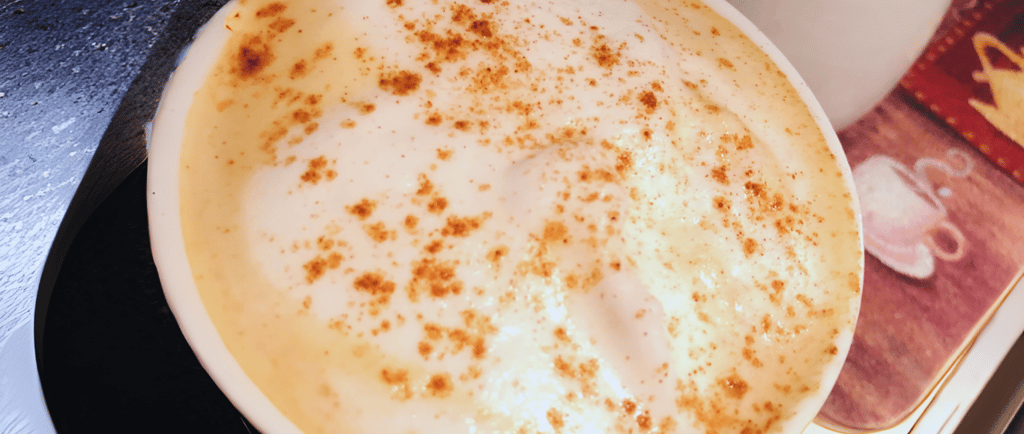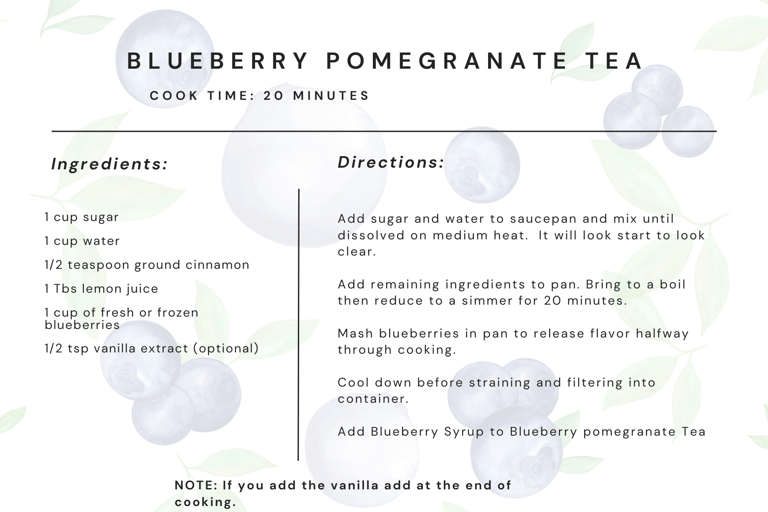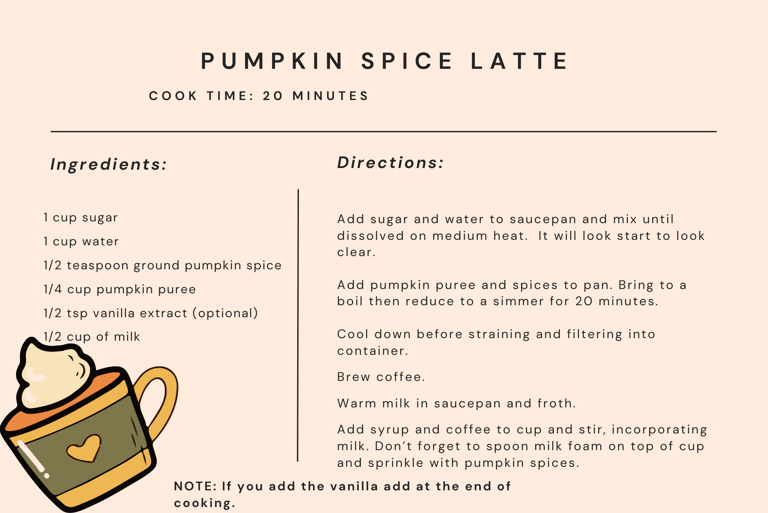How to Make Simple Syrups for Specialty Drinks: Blueberry Pomegranate Tea & Pumpkin Spice Latte
Whip up this easy, quick-to-make simple syrup and transform your favorite coffeehouse drinks at home for a fraction of the cost! In this post, I share my recipes for Blueberry Pomegranate Tea and Pumpkin Spice Latte to show the variety of delicious beverages you can create. Perfect for single servings or large batches to share, these syrups will elevate your homemade drinks in no time.


Simple Syrups for Specialty Drinks: Blueberry Pomegranate Tea & Pumpkin Spice Latte
There was a time when I spent loads of money on specialty drinks from Starbucks and other local coffee shops. My love for coffee spans decades, so when these fancy "froo froo" drinks became available, I was hooked. I couldn’t resist treating myself. But of course, with buying these drinks almost daily, my wallet was feeling it! Oh yes, I was a commuter at the time and passed by my favorite shop every workday. I'll let you compute those figures. Ha ha.
Now, don’t get me wrong, I’m not against still visiting my favorite coffee spots—there's something special about sipping a barista-made drink. But when I realized how easy it was to make these drinks at home, I was ecstatic! Not only could I recreate them whenever I wanted, but I was also saving money in the process. And you can make these drinks too!
Today, I’m sharing two simple syrup recipes for you to try out: my Blueberry Pomegranate Tea and the classic Pumpkin Spice Latte. These syrups are incredibly versatile, and while I love using them in tea or coffee, they also work beautifully in sparkling water or other drinks. Trust me, there are a variety of ways to use them, but I’ll get into more ideas further down in the post.
Unlocking Flavor: How Simple Syrups Elevate Your Favorite Drinks
Where do most of the flavor come from in specialty drinks? It’s the syrup! That sweet, syrupy gold made from a variety of fruits, spices, and in the case of a latte, a veggie—pumpkin. Although technically, it’s a fruit. Simple syrup is just a liquid form of sugar, created by simmering equal parts water and sugar together. This allows the sugar to easily incorporate into your drink. If you've ever made a cold drink using granulated sugar, you know how much stirring it takes to get those sugars to dissolve. Simple syrup solves that problem, making it easy to sweeten your drinks. But we can take it a step further and make that syrup pack a bigger punch by infusing it with other ingredients like spices and fruit. Not only does it add flavor, but it also gives you the creative freedom to customize your drinks, elevating them to a whole new level.
Understanding the Difference: Homemade Syrups vs. Commercial Options
The first thing I want you to be aware of is that the appearance of homemade syrup may not look exactly like those commercial ones, as their ingredients are different and not so simple. Commercial syrups often use additional sugars like corn syrup and undergo ultra-filtering processes to achieve that glossy finish. Nevertheless, our homemade syrups will taste just as great. Why? Because we have complete control over the flavor and consistency! Depending on the intended use, I adjust the thickness of my syrups. I often make mine for more than just drinks—think pancakes or even spicing up recipes like candied yams. For drinks, I usually keep the syrup thinner. The basic ratio is one cup of granulated sugar to one cup of water. As you simmer down the water, it thickens, but adding fruit and other ingredients increases the water content, so I typically add an extra ¼ to ½ cup of sugar for added sweetness. I’ll start you off with the basic recipe and let you discover the perfect thickness and sweetness for your taste!
Note: Remember that refrigerating simple syrup will make it thicker.
How Cook Time Impacts Flavor and Thickness in Simple Syrup
The cook time for simple syrup can significantly affect its flavor, thickness, and overall quality. Here’s how varying cook times—10, 15, and 20 minutes—impact the syrup:
10 Minutes
Flavor: The syrup will have a lighter flavor profile, capturing the essence of the ingredients (like fruits and spices) without a deep infusion. This is great if you want a more subtle flavor.
Thickness: The syrup will be relatively thin, with a consistency similar to water or light syrup. It will be easily pourable but may not coat a spoon well.
Use: Best for drinks or dishes where you want a hint of flavor without overwhelming the main ingredient.
15 Minutes
Flavor: A more pronounced flavor will develop, allowing the ingredients to infuse more fully. This duration balances extraction and avoids overly strong flavors.
Thickness: The syrup will start to thicken slightly, making it better for drizzling over desserts or adding to beverages.
Use: This is a good middle ground, suitable for most applications, where you want flavor and a bit more body.
20 Minutes
Flavor: The syrup will have a robust and rich flavor profile, with deeper notes from the ingredients. This is ideal for creating a concentrated syrup for drinks or desserts.
Thickness: The longer cook time will yield a thicker syrup, which may coat a spoon more noticeably. It can even approach a honey-like consistency.
Use: Great for recipes where a strong flavor and thick syrup are desired, such as glazes or sauces.
General Tips:
Watch for Overcooking: If the syrup is simmered for too long, especially with fruits, it can lose brightness and may develop unwanted bitterness.
Adjusting Consistency: If you prefer a thicker syrup, consider simmering longer, but also note that some ingredients may become too concentrated or lose their fresh flavor.
Cool Down: The syrup will continue to thicken slightly as it cools, so keep that in mind when deciding when to remove it from heat.
Ultimately, the best cook time will depend on your flavor preferences and intended use for the simple syrup!
Using Sugar-Free Options in Simple Syrup
If you're looking to make sugar-free simple syrups, there are some great alternatives to traditional sugar. Here are a few tips and characteristics of sugar-free options:
Stevia: Natural, calorie-free sweetener. It doesn’t dissolve as well as sugar, so it might leave a slight aftertaste.
Monk Fruit: Another natural, calorie-free option. Monk fruit sweeteners dissolve better than stevia and offer a more neutral taste.
Erythritol or Xylitol: These sugar alcohols mimic the texture of sugar and dissolve well, but they may create a cooling sensation in the mouth.
Allulose: A low-calorie sweetener that behaves like sugar, dissolving easily and without the aftertaste of some alternatives.
Each alternative can slightly alter the texture and sweetness level, so you may need to experiment to find the one you prefer!
Endless Possibilities with Simple Syrups
With simple syrups, the drink possibilities are endless! You can make your own ginger ale by adding ginger syrup to sparkling or carbonated water. Don’t like blueberry? Swap it for strawberry, or even mix fruits for a unique twist. I haven’t tried using nuts in my syrups just yet, but I’ll let you know when I do. These syrups keep wonderfully in the fridge for up to two weeks. There may be a little crystallization over time, but don’t worry—it’s minimal. You can also use these syrups as toppings on pancakes, waffles, or anything else that could use a sweet drizzle. I hope you give the blueberry tea and pumpkin spice recipes a try, or even better, come up with your own favorite beverage combinations!








